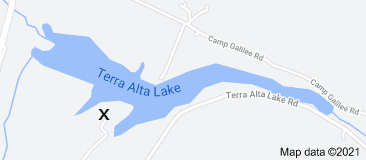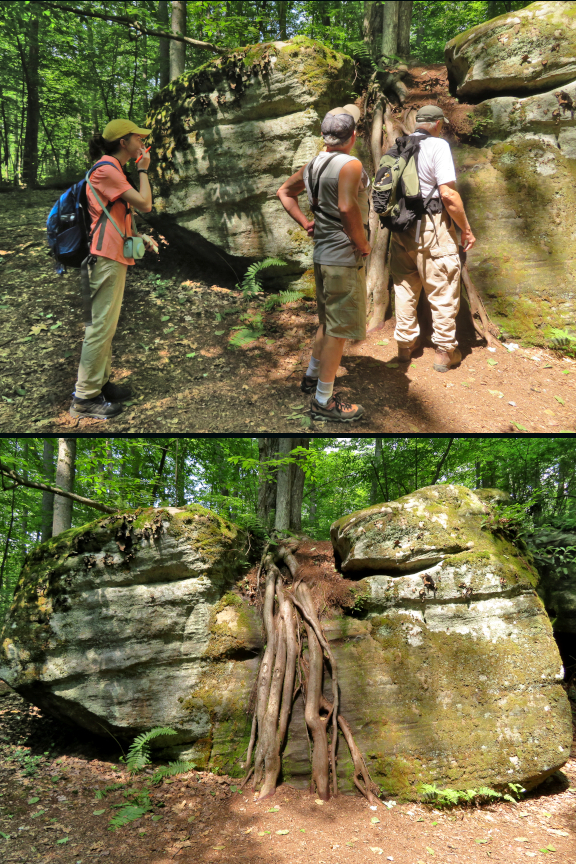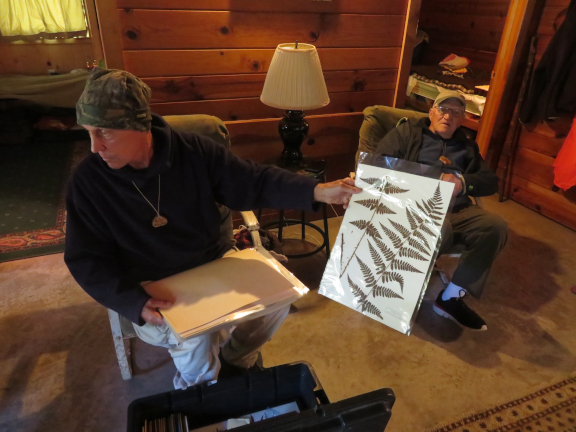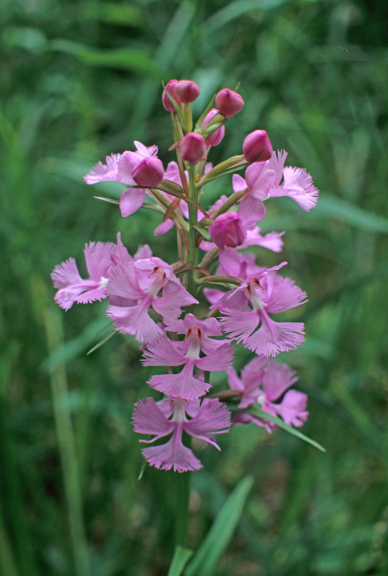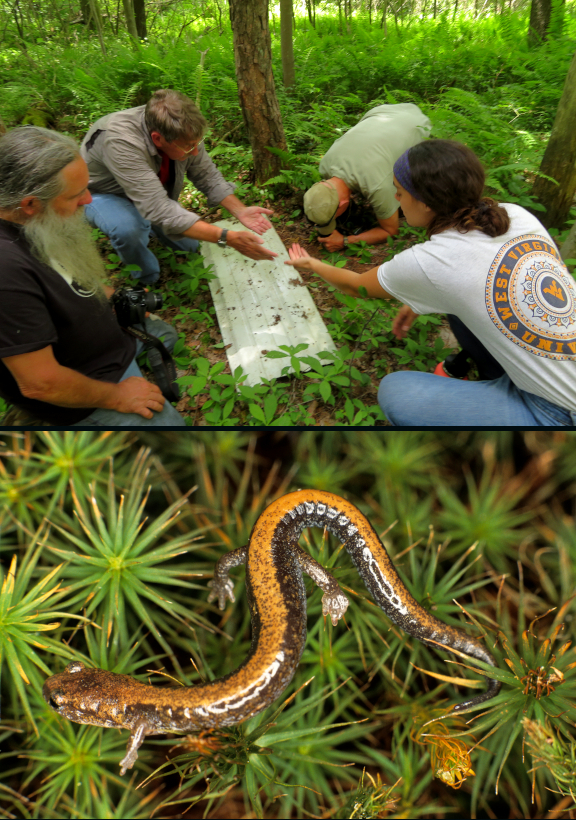This was the 91st year of Mountain Nature Camp! The camp is located on an 18-acre peninsula on Terra Alta Lake in Preston County, West Virginia.
For the first to arrive, the Program/dining hall looked like a bare and lonely setting. But soon it became a place to greet new campers, rekindle old friendships, and, of course, look for the Purple Finches, Golden-crowned Kinglets, Northern Parulas, and Blackburnian Warblers that nest in the spruces adjacent to the building.
Following a long-standing tradition, the first activity after supper on the day we arrived was a campfire. It was a time to meet new campers and to introduce those who have been attending for many years.
On Monday, after a birdwalk and breakfast, we took a field trip to the nearby “Rock Maze” in Garrett State Forest. To everyone’s amazement, right near the beginning of the trail was a Timber Rattlesnake (𝐶𝑟𝑜𝑡𝑎𝑙𝑢𝑠 ℎ𝑜𝑟𝑟𝑖𝑑𝑢𝑠),the first one most of the campers had ever seen in person.
All along the Rock Maze Trail were a wide variety of ferns.
Campers checked out the birch tree roots flowing over the rocks.
After a picnic lunch, threatening thunder and lightning chased us back to our vehicles and eventually back to camp. After the storm passed, campers had time to explore the 18-acre peninsula and the variety of habitats available right at camp.
Traditionally our meals at Mountain Nature Camp are homemade from scratch with fresh ingredients from local farmers and growers. This year didn’t disappoint. What a flavorful, delicious variety we had!
After a birdwalk and breakfast on Tuesday we had onsite classes. The 18-acre peninsula that comprises the Mountain Nature Camp property is home to a wide variety of birds, plants and other creatures. Larry taught an indoor bird class with half of the campers while I taught an outdoor botany class with the others.
Since 2004 (when this record-keeping started) we have found 109 plant species flowering on camp property and the surrounding road during the week (either the 2nd or 3rd week of June) of Mountain Nature Camp.
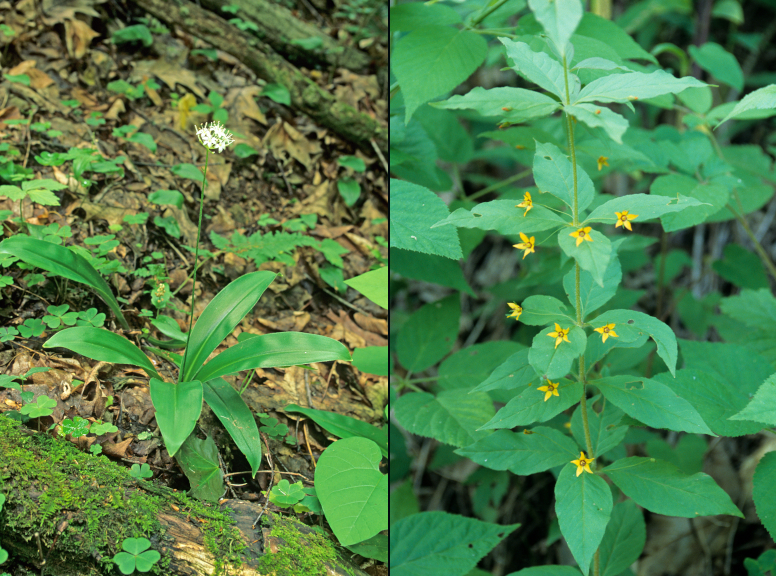
The day ended with a campfire. We shared observations, stories and sang some of Mountain Camp’s traditional songs.

Wednesday was a mixed bag of nature activities. After a birdwalk and breakfast, the campers were taught about Nature Journaling, and more specifically, sketching/painting what one sees in nature.
It was such a beautiful day Bob prepared us a picnic lunch cooked on the grill.
Throughout the day, between classes and other activities, there are always campers chasing after and looking at birds.
During the week campers found a variety of bird nests including, Eastern Kingbird, Purple Finch, Blackburnian Warbler, and Ruby-throated Hummingbird.
Lisa demonstrated how her fold-able kayak snaps together.
Len and Hannah used Randy’s stereo-microscope to look at the Many-headed Slime Mold (𝑃ℎ𝑦𝑠𝑎𝑟𝑢𝑚 𝑝𝑜𝑙𝑦𝑐𝑒𝑝ℎ𝑎𝑙𝑢𝑚) Len was raising at home.
Here I am looking at and showing the pressed fern collection and other materials Mike Breiding donated to the Mountain Nature Camp.
Shortly after that, I photographed the rare Boott’s Wood Fern (𝐷𝑟𝑦𝑜𝑝𝑡𝑒𝑟𝑖𝑠 𝑋 𝑏𝑜𝑜𝑡𝑡𝑖𝑖) that grows on the property. It is a rare hybrid between the Crested Wood Fern (𝐷𝑟𝑦𝑜𝑝𝑡𝑒𝑟𝑖𝑠 𝑐𝑟𝑖𝑠𝑡𝑎𝑡𝑎) and the Intermediate Wood Fern (𝐷𝑟𝑦𝑜𝑝𝑡𝑒𝑟𝑖𝑠 𝑖𝑛𝑡𝑒𝑟𝑚𝑒𝑑𝑖𝑎). Other than Mountain Nature Camp property, it is reported at only one other site in West Virginia.
Near the end of the day a group of us traveled to Chestnut Heights to watch the amazing sunset from high on the ridge and see the synchronous firefly display.
In 2019 our camp group had been dazzled to see a great many fireflies displaying synchronously at Chestnut Heights, but unfortunately this year the weather didn’t cooperate. What we saw in 2019 was something quite amazing, and I will remember it as one of the nature highlights of my life. However, the firefly display on our Mountain Camp property had been impressive on Monday and Tuesday nights this year, similar to the display in the video below, just lacking synchronization.
On Thursday we left camp early for our long field trip day. Most of the campers went on a birding/botanizing trip, while 5 of us hiked in the Dolly Sods Wilderness. The bird/botany group stopped at a farm in Pleasant Valley, MD, to see Red-headed Woodpeckers. Red-headed Woodpeckers are listed as “common locally”, which translates to — they are uncommon in most places, but where they are found, they can be very common. And at this farm they were very common!
Stops in Canaan Valley provided the bird/botany group with looks at some interesting plants like the globally endangered Glade Spurge (𝘌𝘶𝘱𝘩𝘰𝘳𝘣𝘪𝘢 𝘱𝘶𝘳𝘱𝘶𝘳𝘦𝘢).
The group also saw several Large Purple-fringed Orchids (𝘗𝘭𝘢𝘵𝘢𝘯𝘵𝘩𝘦𝘳𝘢 𝘨𝘳𝘢𝘯𝘥𝘪𝘧𝘭𝘰𝘳𝘢).
Canaan Valley State Park and the Canaan Valley National Wildlife Refuge offer many thousands of acres to hike and explore, like this trail/boardwalk in the state park.
And, of course, there is always time to relax, chat and listen to the ethereal songs of Hermit Thrushes.
One of the last stops was at the Freeland Boardwalk Trail in the National Wildlife Refuge for some birding.
The Dolly Sods hiking group followed the Bog to Bog Loop Trail, encompassing both Alder Run and Fisher Spring Run Bogs.
Mountain Laurel (𝘒𝘢𝘭𝘮𝘪𝘢 𝘭𝘢𝘵𝘪𝘧𝘰𝘭𝘪𝘢) flowers were everywhere. Some were still in bud, but most were in full flower. There were all shades of pink and some of the plants had all white flowers. They were exquisite.
Crossing the Beatty Labyrinth rock field.
Randy posing, adding his beauty, to that of Mountain Laurel.
For supper both groups met at Blackwater Falls State Park for a picnic.
On Friday morning, after the early morning bird walk and breakfast, the Friends of Decker’s Creek presented a program on water quality. After a discussion of watersheds, sources of pollution and indicators of water quality, we went to one of the camp’s streams to conduct a survey of the macro-invertebrates in the Mountain Nature Camp’s wetlands.
On Friday afternoon I led a group around the Mountain Nature Camp property looking under rocks and logs surveying for more terrestrial critters. The first log I overturned revealed Hannah’s nemesis, a camel cricket.
We found 2 Red-backed Salamanders.
And there were Woodland Millipedes under everything.
We discovered other wonders of nature just about everywhere we looked.
For me, the most interesting critter we found was this centipede which was in the process of molting its skin.
Saturday came all too soon. After a birdwalk and another delicious breakfast, we packed up and slowly said our goodbyes to friends old and new. We took with us more knowledge and appreciation of Nature and our place in it, as well as memories to last a full year until many of us, and hopefully some new friends, will meet again.
The 2021 Oglebay Institute Mountain Nature Camp campers, or at least, most of them.

